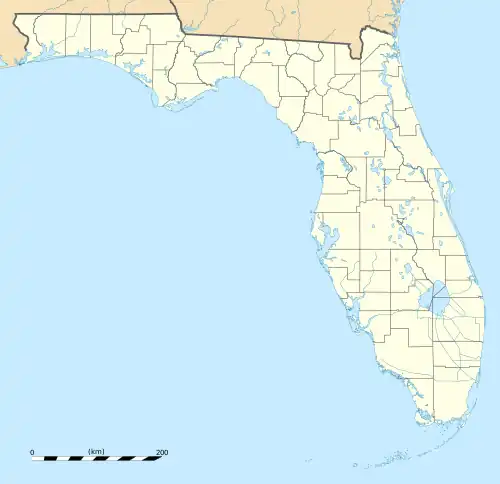Archbold Biological Station
The Archbold Biological Station (ABS) is a research institute with a surrounding 5,192.63-acre (21 km2) estate near Lake Placid, Florida, USA. It is a venue for field research and education, as well as ranching.
Archbold Biological Station | |
 Main building at Archbold Biological Station | |
  | |
| Location | Venus, Florida, USA |
|---|---|
| Coordinates | 27°10′50″N 81°21′0″W |
| Area | 5,192.63 acres (21.0138 km2) |
| Built | 1941 |
| NRHP reference No. | 07000698[1][2] |
| Added to NRHP | July 20, 2007[1] |
History
The station was established in 1941 by Richard Archbold when his sponsorship of zoological research in New Guinea was curtailed by the outbreak of the Second World War in the Pacific region. Archbold acquired the initial land for the biological research station through his friend Donald Roebling from his father, John A. Roebling II.[3] Subsequently, additional land was purchased. On July 20, 2007, the station was added to the U.S. National Register of Historic Places.[1]
Environment
The station encompasses an extensive area of Florida scrub, a scientifically interesting and highly threatened ecosystem. The Station supports 19 federally listed threatened species, including the Sand Skink (Neoseps reynoldsi) and 13 endemic plant species.[4]
Access
The station and grounds are open to visitors, who must register at the main office. There are some displays about the property and its history, a video about the biodiversity and conservation of the Lake Wales Ridge, a 1/2 mile nature trail and picnic tables. Nature and environmental education programs are offered for schools, adults and specialty groups.
Climate
The climate of Archbold Biological Station is classified as humid subtropical (Köppen Cfa), bordering on a tropical monsoon climate (Am), with hot, humid summers and warm, drier winters. Winters are slightly too cool by about three degrees F (2 degrees C) in January. Also its inland location on the well-drained sandy soil of the Lake Wales Ridge allows for high diurnal temperature variation. The record high and record low are 103 °F (39 °C) and 13 °F (−11 °C), recorded on July 4, 1998, and January 5, 2001, respectively.
| Climate data for Archbold Biological Station, Florida, 1991-2020 normals, extremes 1969-present | |||||||||||||
|---|---|---|---|---|---|---|---|---|---|---|---|---|---|
| Month | Jan | Feb | Mar | Apr | May | Jun | Jul | Aug | Sep | Oct | Nov | Dec | Year |
| Record high °F (°C) | 89 (32) |
92 (33) |
95 (35) |
98 (37) |
100 (38) |
102 (39) |
103 (39) |
101 (38) |
99 (37) |
97 (36) |
96 (36) |
91 (33) |
103 (39) |
| Mean maximum °F (°C) | 85.3 (29.6) |
87.5 (30.8) |
90.1 (32.3) |
93.1 (33.9) |
95.9 (35.5) |
97.2 (36.2) |
97.5 (36.4) |
97.3 (36.3) |
95.3 (35.2) |
92.5 (33.6) |
88.7 (31.5) |
86.1 (30.1) |
98.6 (37.0) |
| Average high °F (°C) | 75.0 (23.9) |
78.4 (25.8) |
81.7 (27.6) |
86.3 (30.2) |
90.3 (32.4) |
92.2 (33.4) |
93.3 (34.1) |
93.4 (34.1) |
91.2 (32.9) |
87.3 (30.7) |
81.1 (27.3) |
77.0 (25.0) |
85.6 (29.8) |
| Daily mean °F (°C) | 61.4 (16.3) |
64.2 (17.9) |
67.1 (19.5) |
71.7 (22.1) |
76.3 (24.6) |
80.5 (26.9) |
81.7 (27.6) |
82.1 (27.8) |
80.7 (27.1) |
75.7 (24.3) |
68.9 (20.5) |
64.4 (18.0) |
72.9 (22.7) |
| Average low °F (°C) | 47.8 (8.8) |
50.0 (10.0) |
52.4 (11.3) |
57.1 (13.9) |
62.2 (16.8) |
68.7 (20.4) |
70.1 (21.2) |
70.9 (21.6) |
70.2 (21.2) |
64.2 (17.9) |
56.6 (13.7) |
51.9 (11.1) |
60.2 (15.7) |
| Mean minimum °F (°C) | 25.8 (−3.4) |
29.3 (−1.5) |
33.7 (0.9) |
39.1 (3.9) |
49.0 (9.4) |
61.4 (16.3) |
64.9 (18.3) |
65.5 (18.6) |
62.9 (17.2) |
47.1 (8.4) |
37.5 (3.1) |
30.7 (−0.7) |
23.5 (−4.7) |
| Record low °F (°C) | 13 (−11) |
18 (−8) |
20 (−7) |
26 (−3) |
36 (2) |
50 (10) |
58 (14) |
60 (16) |
55 (13) |
34 (1) |
27 (−3) |
16 (−9) |
13 (−11) |
| Average precipitation inches (mm) | 2.18 (55) |
2.25 (57) |
2.87 (73) |
2.54 (65) |
4.36 (111) |
8.85 (225) |
8.34 (212) |
8.49 (216) |
7.17 (182) |
3.41 (87) |
1.74 (44) |
2.03 (52) |
54.23 (1,377) |
| Average precipitation days (≥ 0.01 in) | 6.9 | 5.9 | 5.9 | 6.2 | 8.2 | 16.3 | 16.5 | 17.6 | 15.6 | 8.9 | 5.9 | 7.1 | 121.0 |
| Source: NOAA[5][6] | |||||||||||||
References
- "Weekly List Of Actions Taken On Properties: 7/16/07 through 7/20/07". National Park Service.
- "National Register Information System". National Register of Historic Places. National Park Service. July 9, 2010.
- Lohrer, Fred E. (July 17, 2017) [2006]. "John A. Roebling, II (1867-1952), Builder of the Red Hill Estate (1929-1941), Lake Placid, Florida" (PDF). Archbold Biological Station. Archived from the original (PDF) on April 2, 2018. Retrieved October 24, 2018.
- Robinson, Amy (30 September 2022). "Ranching and Research at Archbold Biological Station". Vero Beach Magazine. Retrieved 15 October 2022.
- "NOWData - NOAA Online Weather Data". National Oceanic and Atmospheric Administration. Retrieved May 23, 2021.
- "Summary of Monthly Normals 1991-2020". National Oceanic and Atmospheric Administration. Retrieved May 23, 2021.
Bibliography
- Morse, R. (2000). Richard Archbold and the Archbold Biological Station. Gainesville, Florida: University Press of Florida. ISBN 0-8130-1761-0.
External links
 Media related to Archbold Biological Station at Wikimedia Commons
Media related to Archbold Biological Station at Wikimedia Commons- Archbold Biological Station